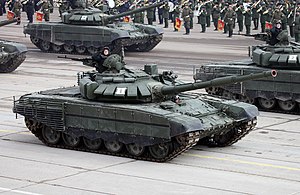LT-77 Main Battle Tank
| LT-77 | |
|---|---|
 LT-77G | |
| Type | Main Battle Tank |
| Place of origin | |
| Service history | |
| In service | 1976- present |
| Used by | |
| Production history | |
| Manufacturer | Sava Industries |
| No. built | 3,500 |
| Specifications | |
| Weight | 44 tons |
| Length | 6.95 meters |
| Width | 3.6 meters |
| Height | 2.25 meters |
| Crew | 3 |
Main armament | 125mm 1SB20 L-type smoothbore autoloading gun |
Secondary armament | KA-75 15mm HMG, LSAC-5 7.62mm LMG |
| Engine | Likanov Engine Factory 1020 H 1,100 horsepower |
| Transmission | LEF T-200 Hydrostatic transmission |
| Suspension | hydropneumatic suspension |
Operational range | 700km w/external fuel drums |
| Speed | 80km/ph |
The LT-77 Main Battle Tank is a series of main battle tanks currently in service with the People's Army of Workers and Peasants. First entering production in 1974, the type is the most numerous tank in service, with over 2400 units available. The LT-77 entered service in 1976, and is considered a 2nd generation main battle tank. The most modern version, the LT-77G2, is considered a 3rd generation MBT. It is currently the oldest Libriran MBT still in active service outside of training units. It is scheduled to be out of inventory by 2035.
Development
LT-60
Development of the LT-77 stemmed directly from the LT-60. The LT-60 was a project to develop the next generation in armored warfare, and although it succeed in most of its originally lofty goals, it was extremely expensive to build, and worse still, time consuming. The design was meant to meld the armor effectiveness of breakthrough tanks, with the flexibility of medium tanks.
the required developmental hurdles caused several compromises to be made, particularly to serviceability and reliability. When the LT-60 began to enter service in 1971, it became clear that in order to fufill the needs of the entire army a different design would be required.
LT-77
in 1972 the Libriran Central Armor Design Board, began to create a simpler, easier to make and manufacturer version of the LT-60. Armed with a derivative of the LT-60s gun but with a modified autloader, engine and armor layout. The tank was not as well protected but slightly faster, and more economical. Intended to be produced only as an emergency measure if a war were declared while the LT-60 was still not fully adopted yet, it eventually was decided to use the LT-60 only in specialized and Guards units, and use the LT-77 as the standard tank for the rest of the army.
Production
Production of the LT-77 was started initially at State Factory #131 in Stepi, however problems with defective tooling caused the production line to be taken down for several months. In the interim production was started at Sava Industrial, which continued producing the tanks even after the tooling issues were resolved.
The LT-77 quickly became the most common MBT in the PAWP, and was exported to various other countries, such as the EUSR. The tank has been produced in numerous versions over its production history, with later LT-77G2s being difficult to associate with the LT-77As that they hail from.
Armor has changed substainially, since production first started, the initial LT-77A had homogenous cast steel armor, along with voids between armor plates to increase protection. Eventually starting with the LT-77C1 the tanks received composite armor, consisting of steel, ceramics, voids, etc to further increase protection. After 1984 all LT-77s were equipped with Reactive armor bricks on their front and sides.
Additional equipment, such as laser rangefinders, has appeared on LT-77s as early as 1979 with the LT-77B4, a command model, however after 1982 all LT-77s began to receive laser rangefinders as standard.